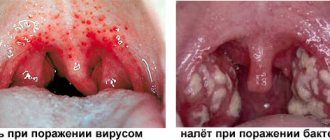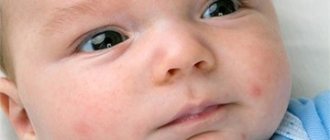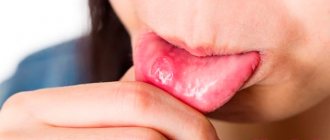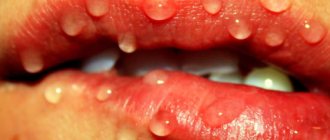This disease has many names: vesicular or aphthous pharyngitis, enteroviral vesicular stomatitis, herpetic tonsillitis (and this is not a complete list). And, oddly enough, the most inaccurate definition, according to doctors, has become established and is most often used - herpetic sore throat.
The fact is that the disease is not caused by a herpes virus or staphylococcus (as is the case with sore throat), but by an enterovirus infection (intestinal). Enterovirus mainly affects children, but the immunity of those who have recovered, as a rule, remains for life.
The disease was assigned a code according to ICD-10 (the worldwide accepted classifier of diseases) – B08.5.
Causes
The causative agent of the disease is the Coxsackie virus (we wrote about what it is here), less commonly, echoviruses (ECHO).
Their penetration into the body occurs through the mucous membranes of the mouth and intestines, after which the infection begins to spread almost everywhere, using the circulatory system as transport highways. Experts call this process “viremia.”
There are several ways to introduce a virus into the body:
- airborne (statistically, the most common);
- contact (through nasal secretions and saliva);
- fecal-oral (due to poorly washed hands, dirty fruits, toys and pacifiers).
Symptoms and signs
Having discovered alarming symptoms in their son or daughter, parents are usually at a loss as to what happened to their child: maybe it’s stomatitis or (if there are skin rashes) chickenpox? Or maybe something cold, since your throat is sore?
Doctors do not recommend wasting time on such diagnostics and self-medication - the disease is quite serious, contagious, quickly transmitted from person to person, and therefore requires urgent medical attention.
Herpangina sometimes develops rapidly, accompanied by the following symptoms:
- the temperature rises to 40 degrees and lasts for 4 days;
- severe pain in the throat;
- runny nose and cough begin;
- weakness is felt throughout the body;
- lymph nodes in the jaw area become enlarged;
- abdominal pain appears (usually in the form of contractions), nausea, diarrhea;
- in very rare cases, the disease is accompanied by a rash on the body, arms and legs.
If we talk about how the disease manifests itself in the throat, the signs will be as follows:
- first, redness appears - on the palate, mucous membranes of the pharynx, in the area of the uvula;
- at the site of redness, nodules form (up to 3 mm in diameter, 15 to 20 in number), which quickly become bubbles;
- salivation increases;
- itching is felt;
- inflamed mucous membranes become very sensitive and may bleed.
Sometimes the disease occurs without the listed symptoms, characterized by only minor redness and swelling.
This makes diagnosis even more difficult, which only an experienced specialist can do.
It can be quite difficult to diagnose an adult, because although the symptoms are similar, the disease does not manifest itself as acutely and painfully as in children.
Purulent sore throat in a child: symptoms, photos and effective methods of treating the disease
Purulent tonsillitis is a type of acute tonsillitis that occurs as a result of untreated follicular or lacunar forms of the disease.
Purulent acute tonsillitis is dangerous due to complications , and when this form of the disease is diagnosed, it is necessary to immediately begin treatment in order to minimize the negative consequences.
Purulent sore throat in children
The disease mainly affects children aged 4-8 years and has pronounced symptoms .
There are four types of purulent tonsillitis in children:
- Phlegmonous. Inflammatory processes affect the fiber in the tonsil area.
Suppuration develops on the left or right side, swelling of the affected organs is also diagnosed as unilateral. - Follicular. Purulent discharge is localized in the follicles of the tonsils; small yellow-green ulcers may appear on the tonsils themselves.
- Fibrinous. It develops in the absence of proper treatment for lacunar and follicular forms of the disease, although sometimes the disease develops as an independent pathology with weakened immunity.
Accumulations of pus spread over the entire surface of the palate. The disease may be accompanied by loss of consciousness, and the child often experiences shortness of breath. - Lacunarnaya. In this form of sore throat, pus flowing from the follicles enters the tonsil canals (lacunae), which leads to the development of inflammatory processes in these areas.
Suppuration is not localized in nature, but looks like a continuous, uniform coating.
Causes of the disease
The reason for the development of purulent sore throat in children lies in the activation of pathogenic microorganisms : pneumococci, staphylococci, streptococci, diplococci and other types of similar infections.
The negative impact from such microorganisms begins only under the following accompanying negative conditions:
- general decrease in immunity ;
- previous diseases of the respiratory organs (influenza, acute respiratory viral infections, lesions due to activation of adenoviruses);
- intoxication;
- hypothermia of the body;
- constant exposure to unfavorable or polluted climatic conditions or dampness;
- poor nutrition;
- emotional fatigue .
The disease can be transmitted from an infected person to a healthy person through airborne droplets, as well as through ingestion of contaminated products and through physical contact with sick people.
Purulent tonsillitis in children manifests itself in the form of the following symptoms:
- pain in the stomach and throat , headaches;
- febrile seizures ;
- increase in body temperature to 40 degrees C;
- nausea and vomiting;
- diarrhea (does not always appear);
- enlarged lymph nodes located under the lower jaw;
- general malaise ;
- aching joints.
Diagnostics
To do this, the following diagnostic procedures are performed:
- A smear to take a sample of material from the affected tonsils (a necessary measure to determine the causative agent of the disease and subsequently prescribe the most effective antibiotic drugs).
- Assessment of the patient's medical history.
- Pharyngoscopy.
- Taking general urine and blood test .
- It is possible to prescribe a PCR (polymerase chain reaction) test if it is impossible to determine the causative agent of the disease by other means.
How does the disease progress?
Purulent tonsillitis is usually severe, but can be easily treated if timely measures are taken.
Body temperature rises in the first two to three days , and the child at this time becomes drowsy and practically does not show normal activity.
There are obvious disturbances in the respiratory processes , which is associated with pain in the throat when swallowing. In rare cases, loss of consciousness is possible.
Treatment of purulent sore throat in children
During treatment, it is very important to maintain bed rest and constantly drink warm liquids , which help dissolve, wash out and remove pus.
If the patient does not refuse to eat, it is advisable to feed the child soft or pureed foods , cereals and soups (solid foods can additionally irritate the throat mucosa).
Medication
How to treat the disease medically? Among medications, the main drugs in the treatment of purulent tonsillitis are antibiotics, which in most cases are prescribed as oral medications.
During inpatient treatment, in especially severe cases, such drugs can be administered as intramuscular injections.
But if a child exhibits allergic reactions to penicillin drugs, it is possible to replace such drugs with cephalosporins and macrolides ( sumamed, cephalexin, cefuroxime ).
Antibiotics
Treatment with antibiotics always involves additional intake of probiotic drugs , which help restore beneficial microflora that die during the main treatment along with pathogenic microorganisms.
Children are prescribed such medications as Linex, Ecoflor, Hilak Forte, Bifiform.
Antiseptic drugs
Lozenges would be useful .
If necessary, the doctor prescribes painkillers and antipyretics . Among such drugs, children are mainly prescribed Nurofen and Eferalgan.
Rinse
Additionally, it is recommended to gargle - for this you can use any of the following compositions, which can be combined with each other:
Traditional medicine
When treating purulent tonsillitis, it is permissible to use traditional medicine.
To treat children, it is better to use one of the following methods, which are safe and effective:
- The outer yellow skin of the onion is filled with water and should be boiled for five minutes, after which the product should sit for three hours. The strained liquid can be used for gargling; this procedure must be performed at least five times a day.
- are grated on a fine grater , after which a glass of boiling water is poured in . In this form, the beets are infused overnight, and in the morning the infusion can be used to gargle. It is advisable to prepare several servings at once, since you need to gargle with this medicine 3 times a day.
- Freshly squeezed aloe juice and honey of any kind are mixed in equal proportions, and this composition must be lubricated on the outside of the throat every day. After lubricating, the neck must be wrapped in a warm scarf for two to three hours.
To treat children, this procedure must be repeated at least four times a day in the first days of the disease.
Disease prevention
It is impossible to recommend 100% effective preventive measures for purulent tonsillitis, but several recommendations can be given that will help reduce the likelihood of a child developing such a disease.
It is also necessary to teach a child from an early age to observe the rules of personal hygiene, since most infectious diseases are transmitted through household means through contact with other patients or objects that they have touched.
You need to properly distribute your time, devoting a sufficient amount of rest : for children, you need to spend about 8-9 hours a day on sleep.
This will help restore the body's internal resources, and this in turn will have a beneficial effect on the immune system.
Reviews about the treatment
“When my granddaughter was sick with a purulent sore throat, the doctor immediately prescribed antibiotics , since the girl suffered from severe pain in the throat and practically could not eat.
But in addition to medications, we were also treated with traditional methods : I lubricated my granddaughter’s throat with honey every day, and several times a day I made sure to make her gargle with water, soda and salt, and the sore throat went away after about a week .”
Tatyana Nikolaevna, Petropavlovsk-Kamchatsky.
“When my eldest son was diagnosed with a purulent sore throat, we suffered a lot, since the treatment was quite long and, as it seemed to me in the first few days, was ineffective.
Despite the fact that we followed all the doctor’s instructions (including gargling, inhalations and taking antibiotics), the treatment process dragged on for two weeks.
As the specialist explained, this happened due to the treatment being started at the wrong time , and I can really admit that in the first three days I did not pay much attention to my son’s alarming symptoms, mistaking them for signs of a mild cold.”
Svetlana Degtyareva, Volgograd.
In this video you will find out whether an antibiotic is needed in the treatment of sore throat in children, according to Dr. Komarovsky:
Purulent tonsillitis is dangerous due to complications , and when this form of the disease is diagnosed, it is necessary to immediately begin treatment in order to minimize the negative consequences.
During treatment, it is very important to maintain bed rest and constantly drink warm liquids , which help dissolve, wash out and remove pus.
Strengthening the immune system through hardening procedures or including foods rich in vitamins in the diet, observing personal hygiene rules - this will help reduce the likelihood of a child developing this disease.
Source: https://prostudanet.com/bolezni/gorlo/angina/vidy/gnoynaya-angina-deti.html
How to distinguish it from other diseases
The disease progresses almost like ARVI, if not for the bubbles in the mouth. This usually alarms mothers and fathers, forcing them to quickly seek medical help for their child.
However, the picture of the disease often looks like that of other, even more serious diseases, and can confuse a novice doctor. How not to make a mistake?
Herpetic sore throat differs from herpes stomatitis in that it affects the palate and pharynx, and stomatitis, in addition to this, also affects the tongue and gums.
We wrote more about the symptoms and treatment of herpetic stomatitis in children and adults here.
Symptoms similar to sore throat accompany a disease such as mononucleosis. In this case, the pain also begins with high temperature, fever, rash and plaque on the tonsils, which soon goes away. Read more about what kind of disease mononucleosis is in this article.
An important point for determining the diagnosis: the disease occurs not in young children, but in adolescents 14-18 years old and very rarely in adults.
Follicular (purulent) tonsillitis is characterized by the fact that it affects only the tonsils. In addition, purulent discharge differs in appearance from the blisters that form in a patient with herpes sore throat.
If the abscesses are the size of millet grains and their boundaries are clearly defined, this is a sign of bacterial tonsillitis.
Other characteristic features for it are the absence of a runny nose and cough (if it appears, it is in the later stages, as a complication). Viral sore throat is always accompanied by a cough.
Dr. Komarovsky will tell you how to distinguish herpangina from streptococcal sore throat:
Features of the appearance of the throat with catarrhal sore throat
The throat with a sore throat in the catarrhal form looks approximately the same as with a regular ARVI - redness of the tonsils and palatine arches is visible, the tonsils themselves are usually very enlarged, especially in children. A grayish coating on the tongue is also clearly visible.
The photo shows a view of the pharynx with catarrhal sore throat:
On a note
In an adult, catarrhal tonsillitis can occur quite mildly, without a significant increase in temperature and deterioration in general condition. In this case, the disease is especially insidious, since patients do not take it seriously, do not take proper treatment and risk getting its typical complications.
It is also useful to read: Is it possible to smoke with a purulent sore throat?
The throat itself with a sore throat in this form looks completely normal. Its mucous membranes do not change, they are not affected by hyperemia. It is this symptom that makes it possible to distinguish catarrhal sore throat from viral pharyngitis, in which redness covers both the pharynx and the back wall of the throat.
How many days does it last and remain contagious?
The incubation period of the disease (the time from the moment the virus enters the body until the first symptoms appear) ranges from two days to two weeks. The course of treatment lasts from 5 to 14 days.
According to the famous pediatrician Evgeniy Komarovsky, the patient poses a danger to others throughout the entire treatment, even after his main symptoms are eliminated. Days 3-5 of the disease are especially dangerous .
You can become infected simply by being in the same room with a sick person, since the causative agents of herpes sore throat spread at a distance of up to two meters from the patient.
Find the main symptoms, causes, treatment methods and photos of herpes on the tongue in our publication.
Instructions for using Belogent ointment are presented in this material.
Do you want to know how to quickly cure herpes on the face? Tips and recommendations - here: https://udermatologa.com/zabol/gerp/lechenie-gerpesa-na-litse-foto-podborodke-shheke-lbu/
Treatment
Therapeutic measures must be comprehensive. This will allow you to quickly eliminate the cause of the disease (bacteria) and its symptoms. The following rules must be observed:
- The child is recommended to have bed rest (limited physical activity).
- It is necessary to exclude from the diet fatty, hot, spicy foods that irritate the mucous membrane of the throat. It is important to give your baby plenty to drink (juices, herbal teas). The drink should be warm.
- Frequent gargling with herbal decoctions will help eliminate pain and help relieve inflammation. If the child is too small and cannot gargle independently, it is recommended to give him some freshly squeezed fruit juice at room temperature every 30-40 minutes.
- The room in which the child is located must be ventilated at least twice a day.
- wet cleaning in the nursery as often as possible .
Read about the symptoms and treatment of acetone syndrome in children here.
Medication
Without medications, treatment of catarrhal tonsillitis is impossible. The child is prescribed:
- antibiotics ( Amoxiclav, Augmentin );
- antipyretics ( Panadol );
- drugs to restore intestinal microflora, preventing the development of dysbacteriosis ( Linex, Acipol );
- vitamin preparations;
- anti-inflammatory drugs ( Ibuklin );
- antiseptic gargles in the form of solutions ( Miramistin, Furacilin );
- sprays ( Ingalipt, Hexoral ) are prescribed to children quite rarely;
- lozenges ( Grammidin, Falimint ).
ethnoscience
Traditional recipes will help speed up the healing process and alleviate the child’s condition. The following traditional medicine methods are used:
- Herbal decoctions for gargling and oral administration (if there is no allergic reaction). Plants such as chamomile, calendula, and mint are used.
- For rinsing, you can also use a saline or soda solution , boiled water with the addition of a small amount of iodine.
- Warm tea (or milk) with honey helps . You can add a slice of lemon to your tea, which will become an additional source of vitamin C.
Recommendations from specialists for eliminating asthenic syndrome in children after illness can be found on our website.
Treatment of herpes sore throat in children
This disease is unlikely for a baby - maternal immunity protects it from the disease.
However, in a one-year-old child, herpes sore throat can develop, and according to a rather severe scenario, with complications.
The main “favorites” of the virus are children aged 3 to 10 years. What is the best way to treat them?
Folk remedies
As an additional treatment, you can use folk remedies, although their choice for children is not very large and is suitable for those who already know how to rinse their mouths. This can be done using apple juice, repeating the procedure every 3 hours.
Forums on the Internet, where parents share their experiences with each other, suggest another original option - give the child a piece of propolis instead of chewing gum; it effectively heals wounds.
This remedy can only be used if the baby does not have an allergic reaction to this substance.
At home, it will be useful to prepare a medicine from honey and garlic. Several cloves are crushed using a crusher, honey and a little water are added and put on low heat: the mixture should simmer for 20 minutes.
Take it orally, a teaspoon at a time. This remedy promotes healing and can relieve pain.
Drugs
Among medications, children are prescribed:
- Viferon, Ergoferon, Arbidol, Isoprinosine - antiviral agents;
- Paracetamol – antipyretic;
- Amoxiclav, Suprax - antibiotics;
- Immunal, Cycloferon - used as immunomodulators;
- Kipferon, Genferon (suppositories) – prescribed in case of complications;
- Enterofuril – against intestinal infections;
- Methylene blue - it is recommended to smear ulcers with it;
- Polysorb - at the final stage of treatment, cleanses the body of drug residues.
But such remedies as Tsitovir, Amiksin, oxolinic ointment, which have proven themselves in the fight against herpes infection, in this case do not give the necessary therapeutic result.
Mouth and throat rinses
The following pharmaceutical preparations are suitable for this purpose: Chlorophyllipt, Miramistin, Furacilin, Cholisal.
If the baby does not yet know how to gargle, the mother needs to learn how to gargle. The listed drugs not only cope with the current problem, but can prevent secondary infection.
Diet and proper nutrition
There are special requirements for the nutrition of a patient with herpetic sore throat.
Food should not only be healthy and rich in vitamins, but also gentle on the baby’s sore throat - liquid or pureed, not hot, not spicy or salty. Chicken broth and liquid porridges fit well into the menu.
But dairy products can be consumed only if the disease is not accompanied by diarrhea (which happens quite often with such a diagnosis).
Drinking should be plentiful and, if possible, varied - jelly, fruit drinks, dried fruit compote, rose hip decoction.
Therapy
Physiotherapy is effective for treating mouth ulcers: 3-7 sessions using a helium-neon laser, as well as ultraviolet irradiation, help achieve the desired result.
Recently, so-called hyposensitizing therapy has become popular, the goal of which is to prevent the patient from developing allergic reactions.
White ulcers in the throat, treatment methods for children and adults |
White ulcers in the throat are a sign of an infectious process that requires differential diagnosis and treatment.
Most often, this symptom indicates the “settlement” of coccal microflora or Pseudomonas aeruginosa on the mucous membrane of the throat and tonsils. Tonsils are a natural barrier that traps microbial cells. This is where the manifestation of inflammatory processes begins.
Abscesses in the throat are called accumulations of lymphocytes, other blood cells, and pathogenic microorganisms. Ulcers look like white-yellow plugs located in the lacunae of the tonsils, on the mucous membranes.
How to get rid of ulcers in the throat, the main reasons for their appearance and the peculiarities of the process in children are discussed in the article.
The causes of the pathological process in adults and children are as follows:
Acute tonsillitis (tonsillitis) is an inflammation of the lymphoid pharyngeal ring with a predominant lesion of the palatine tonsils. The chronic process is not manifested by the appearance of ulcers, but is accompanied by the formation of a whitish coating of a paste-like consistency.
Herpes sore throat is a disease caused by enteroviruses (Coxsackie virus). The main manifestations are a vesicular rash, which is first filled with serous fluid and later purulent. Diphtheria - purulent areas appear on the tonsils and back wall of the pharynx, which merge and form a film.
This film cannot be rubbed with a spatula; when you try to remove it, the mucous membrane begins to bleed. Scarlet fever - ulcers on the tonsils appear in severe cases of the disease. At the same time, a bright red rash appears on the face, neck, hands, feet, and flexor surfaces. Typical for childhood.
Peritonsillar abscess - the tonsil is significantly enlarged, areas with ulcers are visible on the surface, high temperature, severe intoxication of the body. Pharyngitis of a bacterial nature - the inflammatory process can be accompanied by the formation of ulcers on the back wall of the throat.
Burns and mechanical damage - purulent rashes occur only against the background of the addition of bacterial microflora.
Clinical picture
The causes of the pathological manifestation are varied, but in most cases they are accompanied by the same clinical signs. Symptoms of body intoxication appear: increased body temperature, weakness, decreased or lack of appetite, headache. Patients complain of muscle pain, aching bones and joints.
When examining the throat, hyperemia of the mucous membrane, pinpoint hemorrhages, and swelling are determined. The tonsils are enlarged, making swallowing difficult. Eating and drinking are accompanied by pain. Small children refuse to breastfeed (with natural feeding), and their sleep patterns are disrupted. On palpation, enlarged regional lymph nodes are felt.
Against the background of herpes sore throat, the rash looks like watery blisters surrounded by a red border. Later, the contents become purulent, the vesicles open, exposing the erosive surface. Erosions can merge, forming wounds of considerable size on the tonsils and walls of the pharynx.
Purulent rash without fever
In some cases, “ulcers” turn out to be food particles that are stuck in the lacunae of the tonsils due to their loose structure. The pieces disappear on their own, washed off with water, after a few days. No additional assistance is required.
Abscesses in the throat without fever are considered an uncommon symptom, in most cases accompanying latent or atypical forms of the disease. Main reasons:
- an atypical form of acute tonsillitis - develops with improper use of antibiotics, a reduced level of the body's defenses; pharyngomycosis - a fungal infection of the pharynx and tonsils, in which pieces of plaque appear in the form of accumulations of a curdled nature; aphthous stomatitis - small white ulcers in the form of ulcers are formed on the mucous membrane of the throat, cheeks, tonsils, surrounded by a red rim, and can reach a centimeter in diameter.
Features of therapy
An ENT doctor, primary care physician or pediatrician will tell you how to treat emerging ulcers. First of all, it is necessary to determine the causes of the pathological condition, so that therapy includes not only symptomatic treatment, but also etiotropic treatment (aimed at destroying the pathogen).
If the cause of ulcers is a bacterial infection, antibiotics are prescribed based on the results of determining the sensitivity of microbial cells. Preference is given to the following groups due to their low toxicity (allowed in the treatment of pregnant women and children):
- macrolides – Erythromycin, Clarithromycin, Sumamed; cephalosporins – Cefotaxime, Cephalexin, Cefodox; penicillins – Ampicillin, Oxacillin, Ampiox.
Antibacterial agents can be used in the form of tablets, injections, and also in the form of aerosols for local therapy. Probiotics (Lactobacterin, Bifiform, Acylact) and prebiotics (Prelax, Hilak forte, Romfalak) are prescribed with antibiotics to prevent dysbacteriosis and pharyngomycosis.
Aspirin or Ibuprofen is taken to prevent possible complications from the heart and joints. Vitamin complexes are prescribed without fail to strengthen the body's defenses.
Washing the tonsils
The doctor will tell you how to wash the tonsils and how to remove the pathological plaque.
Washing tonsils in the clinic
This is necessary to reduce the number of pathogens and relieve symptoms of intoxication. You can use infusions and decoctions of medicinal herbs, as they have antiseptic properties:
To prepare the solution you need one component or a combination of several. Two tablespoons of raw material are poured into a liter of boiling water and left for several hours. Do not use a hot solution. Rinse the tonsils with a syringe, without using a needle, about 5-7 times a day.
A solution of sea salt (5 g per glass of liquid) will help cure your throat. The course of therapy is a week, 3 times a day. You can also wash the lacunae with Miramistin, Furacilin, Chlorophyllipt.
Rinsing
Used for the treatment and prevention of inflammatory processes. Gargling and gargling of tonsils should be done every 3 hours, alternating with other procedures. How to gargle:
Beetroot juice. Beetroot is used in its unpeeled form. You need to chop one vegetable and add water. Keep on low heat for at least 60 minutes. Next, strain. Yarrow decoction with honey. Sage tea.
Garlic-propolis solution. Pour 3 crushed cloves with a glass of boiling water, after an hour of infusion, add a teaspoon of propolis tincture. Lemon juice diluted with water (1 part juice to 5 parts liquid).
These fortified mixtures are not intended to remove ulcers, but they will strengthen the immune system and speed up recovery.
Recipe No. 1. Combine a glass of kefir, lemon juice (half the fruit), 3 tbsp. l. beet juice and 1 tsp. rosehip syrup. Allowed upon reaching 7 years of age.
Recipe No. 2. Pour a glass of boiling water over the crushed dry raspberry branch and leave for 15 minutes. After straining, add a little linden honey.
Treatment of ulcers in the throat is possible using inhalations. Such procedures can relieve the symptoms of the underlying disease, reduce pain and hyperemia. It is advisable that inhalations be carried out through a nebulizer. The following means are used:
- Miramistin; Furacilin; Cromohexal; Chlorophyllipt; saline; alkaline mineral waters.
Your doctor will tell you how to treat a particular disease that causes ulcers in the throat and tonsils. When choosing a treatment regimen, the patient's age is taken into account. Self-medication is unacceptable, as it can lead to generalization of the pathological process, prolonged recovery of the body and the development of a number of serious complications.
If ulcers appear in the throat, how to treat them
In every person's throat there are collections of lymphoid tissue called tonsils. And now, there are abscesses in the throat - how to treat this scourge?
It turns out that in the nasopharynx there is a lymphatic pharyngeal ring of six tonsils. The palatine and tubal tonsils are paired, and the lingual and pharyngeal tonsils are unpaired. It is the palatine tonsils or tonsils that are best visible when the mouth is open.
The tonsils are already fully developed in the newborn and they perform the function of capturing foreign proteins that enter through the nasopharynx during breathing. In the tonsils, as a hematopoietic organ, lymphocytes are synthesized, they destroy foreign proteins in the form of bacteria, and when they die, they form pus in the form of plugs.
Plugs of pus accumulate in the lacunae and become visible upon examination. Sore throats are catarrhal, follicular and lacunar, according to their pathogenetic mechanisms. Follicular and lacunar form purulent plugs.
How to cure ulcers in the throat if they do form? Pus plugs resolve on their own, but can remain for a long time, creating a focus of chronic infection.
Reasons for the formation of plugs with pus in almond lacunae
Purulent plugs in the lacunae of the tonsils are of infectious origin and are associated with weakened immunity, and the reasons for the appearance of plugs are as follows:
Self-treatment when purulent plugs appear in the tonsils is unacceptable for the following reasons:
A special examination is necessary, which alone can find the cause of the formation of pus in the lacunae of the tonsils. This is only possible in a medical facility. Ulcers in the throat can be a symptom of a dangerous infectious disease. Incorrect treatment can lead to dangerous complications.
Plugs with pus can form not only due to colds, they can appear as a result of smoking and various chronic infections.
Bacteria that cause purulent processes in the tonsils:
- staphylococci; streptococci; pneumococci; enterococci; Pseudomonas aeruginosa; fungus of the candida species.
The culprit behind the creation of purulent plugs in the lacunae of the tonsils, oddly enough, is the organization of the immune system. The fact is that the growth and development of lymphocyte immune cells occurs in the tonsils. Lymphocytes are aimed at destroying foreign biological cells, and these are microorganisms.
In the tonsils, lymphocytes enter the space of the lacunae and there they fight to destroy bacteria. This is how pus is formed from waste products of bacteria, dead bacteria and lymphocytes. The pus acquires a cheesy consistency, fills the space of the lacunae and is visible upon examination as white plugs.
Treatment of purulent sore throats
With weakened immunity, people often have tonsillitis, which turns into a chronic form, tonsillitis. This article shows why chronic tonsillitis is dangerous.
Tonsillitis is characterized by the fact that the tonsils become loose, and inflammatory processes constantly occur in their lacunae, and ulcers appear in the form of plugs. Pseudomonas aeruginosa is especially pathogenic in the throat; treatment of pathologies caused by this microorganism is very long.
How to treat pustules in the throat if the process has already gone far? Medical practice suggests that purulent plugs need to be removed. After the diagnosis is made, antibiotics are prescribed, since without them treatment will be ineffective. The price of antibiotics is low, but the benefits are priceless.
For tonsillitis, acute and chronic, the following antibiotics are prescribed:
These antibiotics are quite new; they suppress the growth of pathogenic staphylococci and streptococci, pathogenic fungi. At the same time with these drugs, the nasopharynx is sanitized, ulcers are removed mechanically, using tweezers or a scalpel, by washing them out through rinsing or with a syringe.
To improve immunity, the doctor prescribes Acetylsalicylic acid, Ibuprofen, Ascorbic acid and other vitamins. Along with oral medications, local treatment is carried out by gargling with solutions that help wash out plugs from lacunae and disinfect the nasopharynx.
Solutions for rinsing the throat for follicular sore throat
Pharmacy solutions for rinsing the throat can be used as their instructions say. The most well-known solutions to cure the throat from pustules have proven themselves as antibacterial and anti-inflammatory agents.
Table 1: Gargling solutions:
How to treat a purulent throat if rinsing is not suitable? In addition to rinsing for follicular sore throat, the drug Lizobact has proven itself well, these are lozenges.
Folk remedies for the treatment of ulcers in the throat
When ulcers appear in the throat, your grandmother can tell you how to treat them. Not because she is a good doctor, but because grandmothers keep proven folk recipes in their memory. How to treat ulcers in the throat - traditional medicine knows the decoctions used in it for gargling, they are very effective and are prepared with your own hands.
Treatment of ulcers in the throat with folk remedies comes down mainly to gargling with decoctions of medicinal herbs. When the diagnosis is established, treatment is prescribed, but the painful phenomena do not disappear as quickly as we would like; traditional medicine knows how to treat an abscess in the throat.
Washing the tonsils is practiced both in medicine and among the people, as this is the most effective method of cleansing purulent discharge.
The best herbs that are used as decoctions are:
Why these plants if there are many others?
The fact is that these herbs have been used repeatedly for a long time and have proven themselves to be the best for this disease.
Of course, there is also sea salt, soda and iodine, but these substances are inferior to the listed herbs in their anti-inflammatory capabilities.
When treating ulcers in the throat, you need not only to clear them from the tonsils, but also to stimulate the healing process, and herbs can do this.
Abscesses in the tonsils are formed as a result of the body’s immune response to pathogenic microflora. Treatment methods have generally been worked out and healing is guaranteed.
Sources:
http://anginamed. ru/simptomy/gnojniki-v-gorle. html
http://gorlor. com/lechenie/obshhie-metody/v-gorle-gnojniki-kak-lechit-318
Source: https://imedic.club/belye-gnojniki-v-gorle-sposoby-lecheniya-u-detej-i-vzroslyx/
Herpangina in adults: how to treat
Treatment for adult patients differs from the pediatric version - different pills, different dosage.
Typically, the doctor prescribes antipyretic drugs (for example, Efferalgan), antiviral (Suprastin), painkillers and antiseptics (Hexoral), immunomodulators (Imudon), antibiotics (if a bacterial infection is added to the underlying disease). You can treat wounds with an inexpensive but effective Lugol remedy.
Herbal decoctions for gargling are good for relieving symptoms of inflammation. Yarrow, chamomile, and coltsfoot are suitable for this purpose.
Beetroot infusion has proven itself well (a vegetable grated and brewed with boiling water should be infused for 6 hours).
Vodka, garlic and cabbage compresses are also useful. The last option is the simplest: fresh cabbage leaves are crushed to a pulp and applied to the throat. With the help of such a simple medicine, it is possible to reduce the fever and facilitate the swallowing process.
The main requirement for these and other compresses is that they should be warm, but not scalding. For children, compresses are not used at all.
Treatment of follicular tonsillitis in childhood and adolescence
If you contact a medical facility in a timely manner, treatment of follicular tonsillitis is carried out at home. At the same time, it is necessary that dishes and personal items are carefully treated with detergents.
Throughout the entire course of treatment, there is a visit to the pediatrician, who monitors the child’s condition, and if there is no positive dynamics of treatment, he will ensure that the small patient or teenager is placed in a hospital setting.
In this case, the following medications are prescribed:
- A course of antibacterial therapy is necessary if a bacterial pathogen is present in the pathogenesis of the disease.
- Dosage forms with an anti-inflammatory effect are prescribed if the etiology of angina is a viral infection.
- In addition, a number of additional medications and procedures are used that eliminate the severity of the inflammation process.
- As an additional method, traditional healing recipes are used under medical supervision.
- Surgery is a radical method of treating sore throat , which is prescribed only if medication does not have the desired effect.
The use of antibacterial agents and antiviral drugs
The most important step in the treatment of this pathological process is the use of antibacterial or antiviral agents.
Their action is aimed at destroying specific microflora. But at the same time, unlike in adult patients, the use of these dosage forms is limited. This is explained by the fact that antibacterial drugs can sometimes have a wide range of side effects and have increased toxicity.
Table. Main action drugs for follicular sore throat in a child
| Pharmacological group | Feature of the action | Dosage | |
| Antibiotics | Antiviral drugs | ||
| Amoxicillin | A drug of the penicillin group with pronounced antibacterial activity. Available in the form of granules for the preparation of a liquid suspension. Approved for use even by the smallest patients in the first year of life. | The dosage is calculated based on the child's weight. Until the age of two (child weight up to 10 kg), a medicine with a percentage of 125 mg is used, three times a day, half a measuring spoon. From two to five years, the dose is set individually (half a spoon, 125 or 250 mg), with a frequency of use three times a day. Ages from 5 to 10 years assume the use of one spoon 3 times a day. The course of therapy lasts from 1 to 2 weeks. | |
| Azithromycin | A dosage form belonging to the pharmacological group of macrolides. It is highly effective, but children do not like it because of its bitter taste, which is why it is recommended to drink it with juice. | The course of treatment does not exceed 7 days with a single dose during the day after meals. | |
| Ceftriaxone | Allows you to achieve positive dynamics in the treatment of follicular tonsillitis, when drugs of the Penicillin group do not have a therapeutic effect. | For children under 12 years of age, the recommended dose is from 20 to 80 mg per 1 kg of body weight. Older age suggests using 1 or 2 grams as a daily dose. The treatment course should not exceed a week. | |
| Macropen | Just like the previous drug, it is effective against bacterial pathogens that are resistant to Penicillin antimicrobials. | The treatment course ranges from 5 to 10 days. The dosage is selected by the pediatrician in each individual case. | |
| Cefodox | The main component of the ingredient that provides the therapeutic effect is Cefopoxime. Can be used when sore throat is aggravated by the development of inflammation of the middle ear. Available in powder form for subsequent preparation of a liquid suspension. | It should be consumed twice a day, preferably with meals. | |
| Arbidol | The main active ingredient Umifenovir allows the use of this medicine in all cases where it is necessary to treat the upper respiratory tract after the penetration and development of a viral infection in them. Can also be used for preventive purposes. | In medical practice, it is allowed for use when the child is 3 years old. In this case, the drug is used once, in a volume of 50 milligrams per day. From 6 to 12 years the dose can be 100 mg, after 12 years 200 mg. The duration of the course is agreed with the doctor. | |
| Viferon | The therapeutic effect is based on the fact that the drug contains recombinant human Interferon. It can be used not only for follicular tonsillitis, but also as a remedy against viral hepatitis and kidney dysfunction due to the influence of a viral agent. Sometimes used for skin diseases caused by the penetration of the herpes virus. | The course of therapy does not exceed 5 days, with rectal suppositories three times a day. | |
| Interferon | Stimulates the immune system, restoring the body's defenses. Can be used in all cases of penetration of viral microflora into the upper respiratory tract. Suitable for children in the form of drops called Grippferon. | In the active phase of the disease, drops are used at intervals of 2 hours, 0.25 ml in each nasal passage. | |
Additional medications
In addition to antibacterial and antiviral drugs, a course of treatment is prescribed, using dosage forms that are aimed at suppressing negative symptoms.
For this purpose, medications of different pharmacological groups are used, but it is taken into account that they will be low-toxic and will not harm the child’s health.
For this purpose the following is prescribed:
- Non-steroidal medications that help relieve the inflammatory process. Usually this is: Ibuklin.
- Ibuprofen.
Ibuklin
Ibuprofen
- If the pathogenesis of the disease involves exposure to an allergen, there is a need to use agents that suppress the production of histamine. These medications are very good at relieving tissue swelling, restoring the process of natural breathing. These drugs are: Loratadine.
- Cetrin.
- Zyrtec.
Zyrtec
Tsetrin
Loratadine
- To relieve the feeling of fever and chills, children are prescribed: Paracetamol.
- Fervex as a hot drink.
Fervex
Paracetamol
- Tablet forms and lozenges are well accepted by children . They like their pleasant taste. But due to the fact that they contain medicinal herbs and essential oils based on them, this creates a risk of developing allergic reactions. Therefore, before using them, you should read the instructions, and the best option would be to consult a pediatrician. Most often prescribed: Anti-angina.
- Septolete.
- Lysobacter.
- Hexoral tabs.
Antiangin
Hexoral Tabs
Lysobacter
Septolete
- Means for gargling and lubricating the tonsils. For this purpose, decoctions and infusions using chamomile, sage or calendula herbs are used. In the pharmacy chain you can purchase: Furacilin solution, or its tablet forms. You can crush them and prepare the solution yourself, and you can make it concentrated (add more tablets).
- Miramistin.
Furacilin
Miramistin
- To perform the procedure for lubricating the tonsils, it is allowed to use: Chlorophyllipt solution
- Lugol's oil solution. Before using it, you should consult your doctor.
Chlorophyllipt
Lugol
- Prebiotics. Medicines of this pharmacological group make it possible to prevent (and, if it occurs, eliminate) the development of dysbiosis in the intestines. It occurs as a result of the action of antibacterial agents, which, in addition to pathogenic microflora, destroy beneficial bacteria. This is also facilitated by drugs with anti-inflammatory effects. For children it is recommended to use: Acipol.
- Bifiform.
- Bifidumbacterin.
Acipol
Bifidumbacterin
Bifiform
- Immunomodulators, vitamins and multivitamin complexes. Under the influence of a bacterial or viral infection, the body's immune forces decrease. And in order to restore the protective barrier and increase the immune status, the following types of drugs are prescribed: Immunal.
- Amiksin.
- Undevit.
- Multitabs.
Amiksin
Immunal
Multitabs
Undevit
Features of therapy in children under one year of age
The formation of palatine tonsils occurs 6 months after the baby is born. This anatomical feature explains the impossibility of developing follicular tonsillitis at this age. However, after 6 months the child may develop this disease.
The occurrence of a sore throat is accompanied by the baby’s hospitalization in a children’s hospital. Constant medical monitoring will prevent the development of complications.
Therapy for follicular tonsillitis occurs according to the following scheme:
- Antibacterial agents are prescribed , if the cause is bacterial pathogens; a viral infection requires the prescription of antiviral drugs. At this age, the dosage is calculated taking into account the baby’s weight.
- In parallel, prebiotics are used (in this case, Simbivit or Lactobacterin are suitable).
- High temperature during sore throat must be eliminated by using antipyretics (children's Paracetamol or Panadol), otherwise the chance of developing seizures increases.
- Treat the throat with furatsilin solution . To do this, you need to apply a medicinal solution to a sterile napkin, and then treat the tonsils with it. To make the procedure easier, you can wrap the napkin around your finger.
Rinses, sprays and tablet forms are not used during this period of life. Rectal suppositories and intramuscular injections of medications are best suited.
Operative therapy
Treatment of follicular tonsillitis using surgical intervention is a method that is used in the absence of positive dynamics in the treatment of this disease.
Criteria for the operation:
- The occurrence of negative consequences that pose a threat to the child’s daily life.
- The frequency of sore throat development is more than 4 times per year.
- Disruption of the natural breathing process due to severe hypertrophy of the palatine tonsils.
Folk recipes
Despite the external harmlessness of medicinal herbs, parents need to remember that they can cause an allergic reaction, which will aggravate the course of the disease.
Any decoction or infusion can be used only after consultation with a pediatrician. In addition, the first day of using a traditional medicine recipe should be accompanied by an examination of the child’s skin surfaces.
Any manifestation of itching, redness or skin rashes is a reason to immediately cancel the folk remedy.
The following types of recipes have the safest effect:
- Small slices of lemon, honey, or raspberry or currant jam are added to tea as a hot drink.
- An infusion of chamomile inflorescence, rose hips or sage can be used throughout the day as an alternative to tea.
- A decoction of oak bark, dry eucalyptus leaves , when brewed, can be used as a means for gargling.
- You can make your own means for rinsing the tonsils by combining grated medium-sized beets with the addition of a tablespoon of apple cider vinegar . After squeezing the resulting juice through a gauze cloth, you can gargle three times a day (before this, let it brew for an hour).
How to treat infants and women during pregnancy
Experts think mainly theoretically about the danger of herpes sore throat for a pregnant woman and the fetus, since cases of the disease in expectant mothers are very rare, but if this happens, the disease usually proceeds easily, without consequences.
However, the description of the possible development of events suggests that the Coxsackie virus can overcome the placental barrier, therefore, in case of illness, a woman must be under the supervision of a doctor.
In the first weeks of pregnancy and in the first months after the birth of a child, a woman’s immunity is weakened, so contact of a pregnant and nursing mother with patients should be completely excluded.
If a woman does get sick, her sore throat lasts an average of 7-8 days, the doctor selects treatment. Is it possible to breastfeed the baby in this situation? In principle, yes, since the virus is not transmitted through breast milk .
However, a problem arises if a woman has to take any antiviral drugs, and hygiene requirements become more stringent.
In this regard, the question of whether it is possible to continue breastfeeding and how to do it safely for the baby is decided by the doctor.
This disease is very dangerous for infants. The diagnosis of herpes sore throat is usually a reason for hospitalization of the child.
In treatment, doctors use antibiotics, antipyretics, painkillers (Tantum Verde and the effective spray Ingalipt), and antihistamines.
This article discusses the main symptoms and treatment with photos of herpes zoster in humans. Find out more!
If you are interested in how to treat herpes on the lip during pregnancy safely and effectively, read our publication.
Appearance of the throat with lacunar sore throat
With lacunar angina, ulcers appear as large diffuse spots on the surface of the tonsils, sometimes as a network of extensive ulcers. Below is a photo of the throat with the lacunar form of the disease:
Again, these ulcers are found only on the tonsils. If they go beyond the tonsils, it means that we are not talking about a sore throat. A plaque similar to pus in this form of the disease can appear with the following pathologies:
- Infectious mononucleosis. The photo shows the appearance of the tonsils:
This disease is also characterized by the development of a runny nose and rash on the body (it is caused by a virus from the herpesvirus group), and it is easily diagnosed with a blood test; - Fungal pharyngitis - with it, the plaque usually spreads far beyond the tonsils;
- Diphtheria, in which a thick coating usually appears on the roof of the mouth above the tonsils. Here the difference with a sore throat lies not only in the location of the plaque itself, but also in its structure. If you put it in a glass of water, it will fall to the bottom and will not dissolve. Pus from a sore throat dissolves in water;
- Simanovsky-Vincent's tonsillitis (ulcerative-membranous), in which ulcers also appear on the tonsils with a thick, dirty coating. It is important that this disease often affects only one tonsil, which is not typical for lacunar streptococcal tonsillitis.
There are cases when on one tonsil a sore throat manifests itself in a typical follicular form, on the other - in a lacunar form. For example, in the photo there is a throat with such a sore throat in an adult:
However, situations where pus is present on one tonsil and not on the other are extremely rare. This, on the other hand, often happens with chronic tonsillitis.
The pictures below show a sore throat with different types of sore throat and clinically similar diseases:
From left to right: view of the pharynx with catarrhal angina, with lacunar angina and with follicular
From left to right: fungal infection of the pharynx (pharyngomycosis), Simanovsky-Vincent angina, peritonsillitis
On the left - pharyngeal hyperkeratosis, on the right - chronic tonsillitis
Diphtheria at an early stage (left) and at the culmination of its development (right)
As a result, it is possible to put together all the signs, the presence of each of which indicates that in this case the patient does not have a sore throat, but another disease.
It is also useful to read: When does the contagious period of sore throat begin and how long does it last?
Doctor Komarovsky's point of view
Since an effective antiviral drug that would help quickly cope with herpes sore throat has not yet been invented by scientists, Dr. Komarovsky is convinced that treatment should be carried out in three areas:
- reduce the concentration of the virus in the patient’s body;
- try to improve the condition of a sick baby;
- protect against the addition of any additional infection to the enterovirus.
Antipyretics, according to the pediatrician, can be given at temperatures above 38 degrees, as well as in the presence of alarming symptoms such as the appearance of seizures.
To improve the patient’s condition, it is necessary to temporarily abandon diapers, which impair the body’s thermoregulation, and excessive wrapping and tight swaddling. Drinking plenty of fluids is necessary.
As for medications, Komarovsky is very categorical; he is against the use of drugs in this situation to treat herpetic infections (such as Acyclovir and Gerpevir), although many of his colleagues do not rule out such treatment.
Diagnostics
In order to identify the presence of the disease, the doctor examines and interviews the patient for clinical manifestations characteristic of catarrhal tonsillitis. The following diagnostic methods are used:
- Examination of the patient's throat (in particular, tonsils) using a special mirror.
- Palpation of the lymph nodes (with catarrhal tonsillitis they become painful and enlarged).
- General blood test (in the presence of an inflammatory reaction in the body, the ESR indicator increases, the level of leukocytes increases).
- A throat swab is necessary to identify the causative bacteria.
- Serological testing (allows us to identify the presence and nature of antibodies).
- Pharyngoscopy method (allows you to assess the condition of the pharyngeal mucosa).
Is it possible to avoid spring vitamin deficiency for children? Find out the answer right now.
Possible complications and consequences
As a rule, the disease passes without any unpleasant consequences. And even relapse is an extremely rare option.
However, if the body is very weak, and the pathogen has managed to penetrate its various tissues, complications are possible that are more dangerous than the disease itself: meningitis, encephalitis, pyelonephritis.
In children under one year of age, these diseases are fatal in exceptional cases.
Among adult patients, the most severe consequences of the disease are observed (and, unfortunately, not 100% cured) in HIV patients.
Possible complications
Untimely and incorrect treatment can lead to the development of the following diseases:
- submandibular lymphadenitis;
- acute otitis;
- retropharyngeal abscess;
- rheumatism;
- heart disease, including heart failure;
- meningitis, sepsis, myocarditis;
- kidney diseases;
- arthritis.
If treatment is started at the wrong time, even for a mild form of the disease, it can lead to the development of more severe forms that require additional treatment.
Prevention: necessary measures
Doctors do not hide the fact that a vaccine has not yet been invented against herpangina and there are no special, specific recommendations for prevention.
Doctors' advice boils down to the need:
- maintain a healthy lifestyle;
- strengthen the immune system in every possible way;
- Avoid close contact with the sick person and wear a mask on your face while caring for him.
In children's institutions, when cases of herpetic sore throat are detected, a two-week quarantine is prescribed, and each employee undergoes a medical examination.
Reviews
Anastasia T.: “I wanted to treat my child’s throat with folk remedies, but unlike ordinary colds, herpes sore throat turned out to be stronger than them. My advice to parents is to immediately contact doctors, then the disease will pass quickly, without complications.”
Oleg P.: “Although I’m not a big fan of programs about health, when Dr. Myasnikov hosts them, I watch them because I respect his opinion. In a program about various viral diseases (stomatitis, herpes sore throat), for example, he correctly said that no matter how hard we try to make our apartments sterile, it will not work: people live in them, and everyone (inside the body, on the mucous membranes) - your own set of microbes. Therefore, it is better to restore order in your own body than to wipe the furniture with a cloth and scrub the floors from morning to evening. How to do it? Play sports, go hiking with your children, swim in the pool, go to the sea in the summer, eat well, not fast food.”
Julia L.: “Beets, cabbage and aloe helped me cure my daughter’s herpes sore throat. The doctor recommended gargling the child’s throat (the procedure should not be one-time, but frequent), and not only with pharmaceutical products (I prepared gargles with iodine and soda), but also with the juice of these vegetables and plants - they heal wounds well.”
General symptoms
Symptoms of the disease appear after the incubation period has ended, often lasting 1-2 days. The main signs of pathology in an adult:
- Sudden deterioration in general condition.
- Hyperthermia, fever.
- Signs of poisoning with pain in the head, aches, and general malaise.
- The throat hurts severely, discomfort increases when swallowing food.
- Loss of appetite, insomnia.
- Enlarged lymph nodes, painful when palpated. First of all, the nodes under the jaw will suffer.
- Plaque on the tonsils, swelling, formation of local neoplasms of a yellow hue. A similar picture is typical for the follicular variety of the disease. With lacunar tonsillitis, the tonsils are covered with a purulent coating with irregularly shaped areas.
Seeking help from a doctor should be done immediately if the following signs of tonsillitis appear:
- Pallor of the skin, appearance of a blue tint.
- Sudden drop in temperature.
- Impaired consciousness.
- Decrease in the volume of urine excreted.
- Convulsive states, unconsciousness.
- The occurrence of hemorrhages.
- Difficulty breathing, increasing sore throat in the child.
- Discomfort during urination.
The main signs of pathology will be a sudden increase in temperature to 39 degrees and the occurrence of acute discomfort in the larynx. It will interfere with conversation and chewing food. Subsequent diagnosis and treatment depend on what a sore throat looks like. If initial symptoms of the disease occur, you should immediately consult a doctor. When, after examination, he determines that the lymph nodes are enlarged, a change in the color of the tonsils, and the uvula, then immediate treatment is required.
Hyperthermia, elevated temperature.










